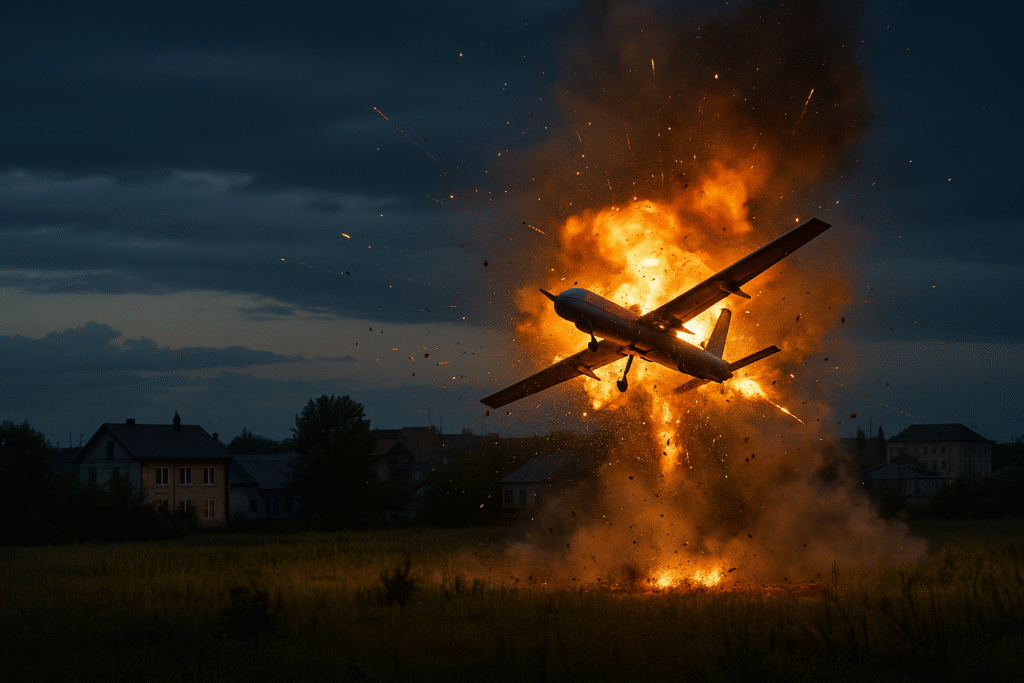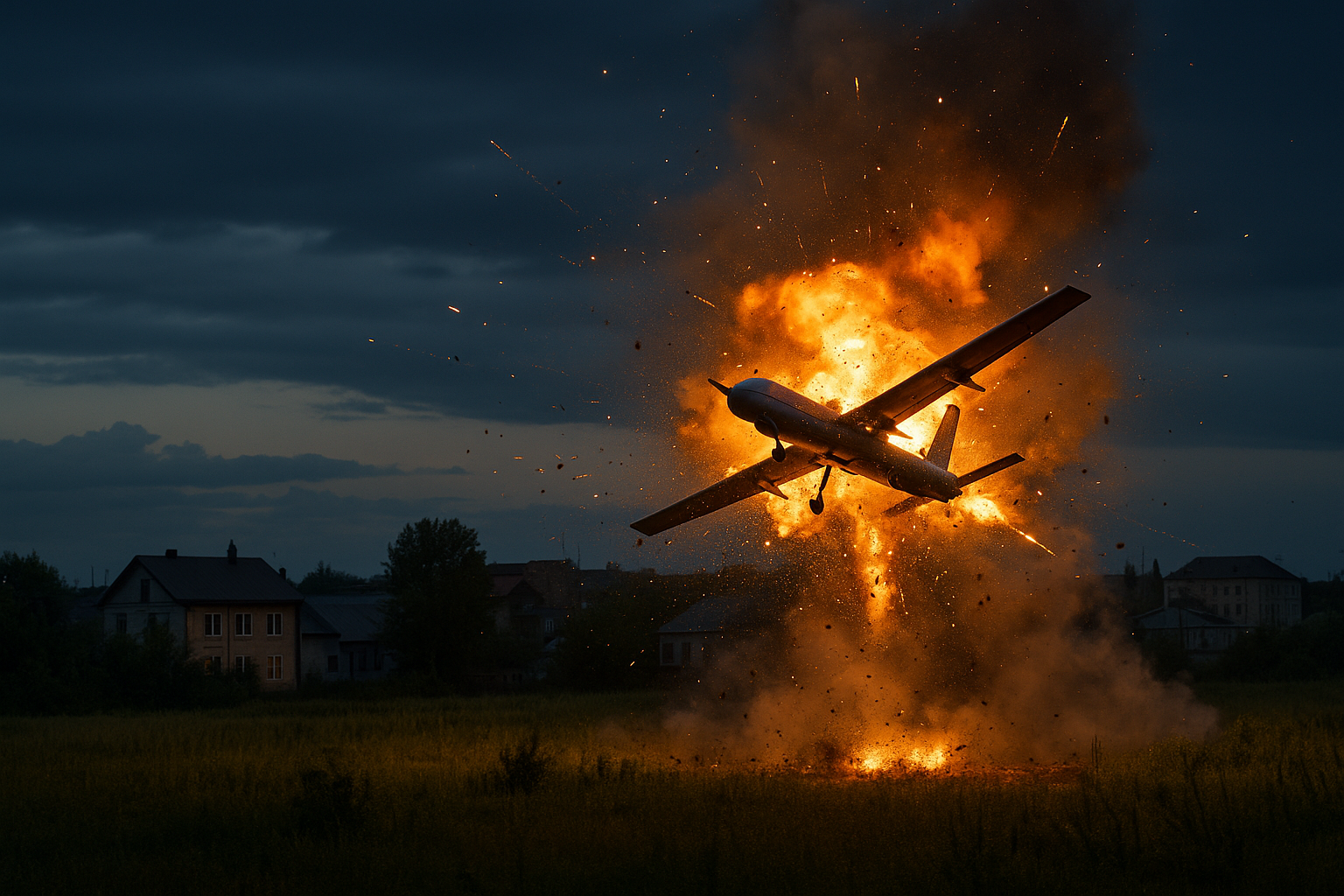The overnight raid marked one of the largest drone strikes attempted by Ukraine in recent months. With Russia destroys 55 drones as the operative outcome, the swift response by Russian military units prevented what could have been a catastrophic breach of national airspace.
The drones, equipped with reconnaissance and explosive payloads, targeted military training grounds, radar installations, and logistical infrastructure near the Lipetsk air base. According to military officials, interceptors and electronic warfare systems were deployed to jam communications, neutralize guidance systems, and eliminate the UAVs mid-air.
As the headline Russia destroys 55 drones reverberates through global media, military analysts are calling the successful interception a testament to Russia’s advanced aerial defense grid.
Civilian Areas Not Spared, But Losses Minimized
While Russia destroys 55 drones speaks to military success, regional authorities confirmed that several drones slipped through initial defenses, causing limited damage in civilian areas. In Lipetsk and Voronezh, at least a dozen residential and non-residential structures sustained damage. Broken windows, collapsed walls, and minor fires were reported, although none of the incidents resulted in fatalities.
Regional governors issued public statements assuring citizens that emergency services were promptly deployed. Several individuals were injured, mostly from glass shards and minor burns, but all are currently in stable condition. As one local official summarized, “We’re grateful that Russia destroys 55 drones quickly enough to prevent what could have been a far worse situation.”
Strategic Significance of Lipetsk
Lipetsk has long been considered a cornerstone of Russia’s military infrastructure. The city houses the principal training center for the Russian Aerospace Forces, where fighter pilots undergo advanced simulation and combat readiness programs. It’s no surprise that the bulk of Ukraine’s drone offensive zeroed in on this target.
Yet, Russia destroys 55 drones has come to symbolize a successful deterrent—underscoring Moscow’s preparedness and rapid response capabilities even in high-value areas. Satellite imagery post-strike reveals no significant damage to the Lipetsk air base, reaffirming official claims that the attack failed to achieve its strategic goals.
Ukrainian Offensive: A Shift in Tactics
Ukraine’s use of drones in the conflict with Russia has been steadily increasing. As supply chains become more agile and drone technology evolves, UAVs offer a cost-effective means for Ukraine to strike beyond the front lines.
However, Russia destroys 55 drones illustrates the limitations of such tactics when faced with robust electronic warfare and layered air defenses. While drones can act as force multipliers, this attack demonstrates that quantity alone is insufficient when countermeasures are efficient and immediate.
Military experts believe Ukraine was testing new routes and aerial strategies with this large-scale drone barrage. If so, the headline Russia destroys 55 drones may also represent a new phase in aerial warfare—one where unmanned systems face highly adaptive adversaries.
Regional Stability Under Threat
Despite the apparent success encapsulated by Russia destroys 55 drones, the psychological toll on civilians cannot be understated. Residents in Lipetsk and Voronezh were awakened by sirens, low-flying objects, and distant explosions. Many spent the night in bomb shelters or designated safe zones.
Authorities have since increased patrols, launched public awareness campaigns, and initiated drone-preparedness drills. Emergency hotlines were also activated to support those affected by the psychological impact of the attempted strike.
The phrase Russia destroys 55 drones may signal victory in military terms, but it also reflects a population increasingly exposed to the realities of modern warfare.
International Reactions
As news of the event broke, world leaders and defense analysts reacted with both concern and admiration. Some Western media outlets acknowledged the scale and coordination involved in the Ukrainian drone strike, while others emphasized the effectiveness of Russian countermeasures.
From China to the Middle East, headlines echoed the theme: Russia destroys 55 drones, showcasing advanced defense technologies in action. Defense correspondents noted that this event may serve as a blueprint for future responses to mass drone threats in both military and civilian sectors.
A Wake-Up Call for Drone Warfare Strategy
One clear takeaway from the incident is that drone warfare is evolving—and so are counter-drone technologies. The fact that Russia destroys 55 drones overnight demonstrates a mastery of radar detection, signal jamming, and automated interception techniques.
Experts predict an arms race in drone and anti-drone technology as a result. The tactical maneuver of Russia destroys 55 drones proves that even a swarm attack can be neutralized if defenses are layered, decentralized, and proactive.
Strengthening Border Defenses
Following the attack, Russian officials confirmed plans to further bolster border security in high-risk zones. Additional air defense systems will be installed, and surveillance operations will be intensified along the western frontier.
The goal is simple: ensure that future headlines continue to read Russia destroys 55 drones, rather than reporting successful penetrations or casualties. Already, procurement contracts for newer anti-drone systems like Pantsir-S1 and S-350 have been accelerated.
Humanitarian and Civil Response
Despite the trauma, community resilience is visible across Lipetsk and Voronezh. Volunteers are helping with repairs, local businesses are donating supplies, and emergency crews are working tirelessly. The Russia destroys 55 drones event, while traumatic, has also united local communities in shared resolve.
Families whose homes were damaged are being relocated to temporary shelters, and financial aid has been promised by the federal government. Psychologists and trauma counselors have also been dispatched to support children and vulnerable individuals affected by the attack.
Conclusion: Russia Destroys 55 Drones – A New Era of Defense
The bold headline Russia destroys 55 drones will likely remain in the news cycle for weeks, and for good reason. This large-scale defense operation is not just a response—it is a signal to adversaries that Russia remains vigilant, equipped, and ready to neutralize emerging threats.
While injuries and damage were sustained, the coordinated effort across military and civil structures prevented a catastrophe. Moving forward, the focus will likely shift to prevention, resilience, and diplomacy. But as of today, the phrase Russia destroys 55 drones marks a critical win in an increasingly complex aerial battlefield.


2 thoughts on “Russia Destroys 55 Drones, Minimizes Civilian Harm”
Comments are closed.